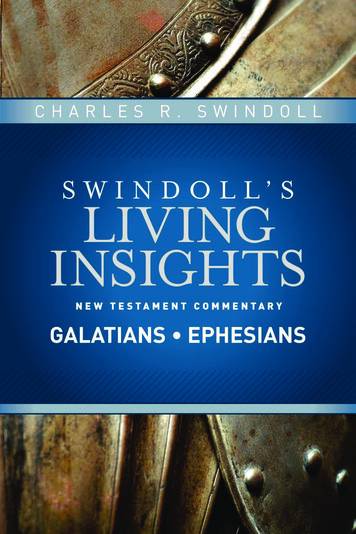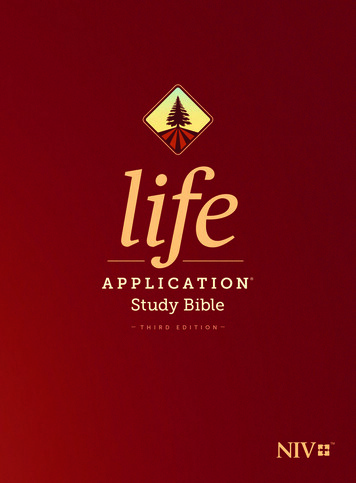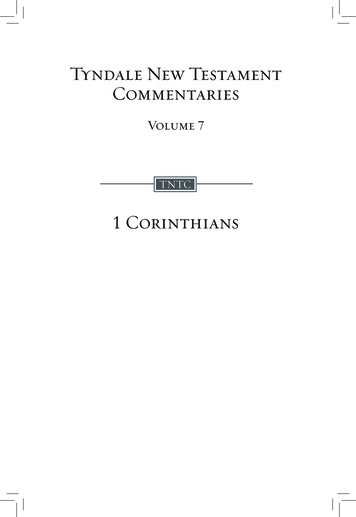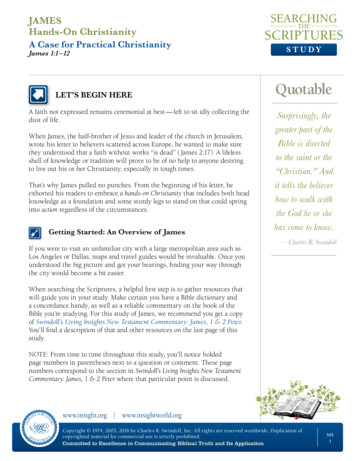
Transcription
CHARLES R. SWINDOLLS W I N D O L L’ SLIVINGINSIGHTSN E W T E S TA M E N T C O M M E N TA RYGALATIANS, EPHESIANSTyndale House Publishers, Inc.Carol Stream, Illinois
Swindoll’s Living Insights New Testament Commentary, Volume 8Visit Tyndale online at www.tyndale.com.Insights on Galatians, Ephesians copyright 2015 by Charles R. Swindoll, Inc.Cover photograph copyright Media Bakery. All rights reserved.All images are the property of their respective copyright holders and all rights are reserved.Maps copyright 2015 by Tyndale House Publishers, Inc. All rights reserved.Photograph of notebook copyright jcsmilly/Shutterstock. All rights reserved.Designed by Nicole GrimesPublished in association with Yates & Yates, LLP (www.yates2.com).Scripture quotations marked NASB are taken from the New American Standard Bible, copy‑right 1960, 1962, 1963, 1968, 1971, 1972, 1973, 1975, 1977, 1995 by The Lockman Foundation,La Habra, Calif. Used by permission. All rights reserved. For permission to quote informa‑tion, visit http://www.lockman.org.Scripture quotations marked NLT are taken from the Holy Bible, New Living Translation,copyright 1996, 2004, 2015 by Tyndale House Foundation. Used by permission of TyndaleHouse Publishers, Inc., Carol Stream, Illinois 60188. All rights reserved.Scripture quotations marked NIV are taken from the Holy Bible, New International Version NIV. Copyright 1973, 1978, 1984, 2011 by Biblica, Inc. Used by permission.All rights reserved worldwide.Scripture quotations marked RSV are taken from the Revised Standard Version of the Bible,copyright 1952 [2nd edition, 1971] by the Division of Christian Education of the NationalCouncil of the Churches of Christ in the United States of America. Used by permission.All rights reserved.Scripture quotations marked KJV are taken from the Holy Bible, King James Version.Scripture quotations marked NKJV are taken from the New King James Version Copyright 1982 by Thomas Nelson, Inc. Used by permission. All rights reserved.Scripture quotations marked ESV are from the ESV Bible (The Holy Bible, English StandardVersion ), copyright 2001 by Crossway, a publishing ministry of Good News Publishers.Used by permission. All rights reserved.Scripture quotations marked NET are taken from the NET Bible copyright 1996‑2006 byBiblical Studies Press, L.L.C. All rights reserved.Scripture quotation from the NEB is taken from The New English Bible, copyright Cam‑bridge University Press and Oxford University Press 1961, 1970. All rights reserved.The “NASB,” “NAS,” “New American Standard Bible” and “New American Standard” trade‑marks are registered in the United States Patent and Trademark Office by The LockmanFoundation. Use of these trademarks requires the permission of The Lockman Foundation.TYNDALE, New Living Translation, NLT, and Tyndale’s quill logo are registered trademarksof Tyndale House Publishers, Inc.Library of Congress Cataloging-in-Publication DataSwindoll, Charles R.Galatians, Ephesians / Charles R. Swindoll.pages cm. — (Swindoll’s living insights New Testament commentary ; Volume 8)Includes bibliographical references.ISBN 978-1-4143-9376-6 (hc)1. Bible. Galatians—Commentaries. 2. Bible. Ephesians—Commentaries. I. Title.BS2685.53.S95 2015227'.407—dc232015033837Previously published by Zondervan under ISBN 978‑1-4143‑9740‑5Printed in the United States of America21 20 19 18 17 16 157 6 5 4 3 2 1
CONTENTSAuthor’s Preface . . . . . . . . . . . . . . . . . . . . . . . . . . . . . . . . . . . . . . . . . . . . . . . . . . vThe Strong’s Numbering System . . . . . . . . . . . . . . . . . . . . . . . . . . . . . . . . . . . viiIntroduction: Galatians. . . . . . . . . . . . . . . . . . . . . . . . . . . . . . . . . . . . . . . . . . . . . 3Confirming the Truth of the Gospel (Galatians 1:1–2:21) . . . . . . . . . . . . . . . 12Another Gospel Is Not the Gospel (Galatians 1:1‑10). . . . . . . . . . . . . . . . . . . 13Radical Transformation (Galatians 1:11‑24) . . . . . . . . . . . . . . . . . . . . . . . . . . 25A Gospel worth Accepting and Affirming (Galatians 2:1‑10) . . . . . . . . . . . 34Going Head- to- Head with Hypocrisy (Galatians 2:11‑21). . . . . . . . . . . . . . . 44Defending the Superiority of the Gospel (Galatians 3:1–4:31). . . . . . . . . . 58Backsliding into Legalism (Galatians 3:1‑14). . . . . . . . . . . . . . . . . . . . . . . . 60A Promise You Can Count On (Galatians 3:15‑22). . . . . . . . . . . . . . . . . . . . . 74From Law to Faith: Our New Status in Christ (Galatians 3:23–4:11) . . . . . 83Caring Enough to Tell the Truth (Galatians 4:12‑20). . . . . . . . . . . . . . . . . . 94To Those Who Want to Be under the Law (Galatians 4:21‑31). . . . . . . . . . 100Living the Freedom of the Gospel (Galatians 5:1–6:18). . . . . . . . . . . . . . . 109Freedom, Faith, Love, and Truth (Galatians 5:1‑12). . . . . . . . . . . . . . . . . . . 112Learning to Walk in Freedom (Galatians 5:13‑25). . . . . . . . . . . . . . . . . . . . . 119Living Together in the Spirit (Galatians 5:26–6:10). . . . . . . . . . . . . . . . . . . 132A Brief Reprise and a Blunt Reproof (Galatians 6:11‑18). . . . . . . . . . . . . . . 141Introduction: Ephesians. . . . . . . . . . . . . . . . . . . . . . . . . . . . . . . . . . . . . . . . . . . 151Sovereignty and Grace: The Foundations of Our Faith(Ephesians 1:1–2:10). . . . . . . . . . . . . . . . . . . . . . . . . . . . . . . . . . . . . . . 160Unloading the Theological Truck (Ephesians 1:1‑14) . . . . . . . . . . . . . . . . . 161Our Prayers and Christ’s Position (Ephesians 1:15‑23). . . . . . . . . . . . . . . . . 173You Were Dead, but God . . . (Ephesians 2:1‑10). . . . . . . . . . . . . . . . . . . . . . 183Reconciliation and Peace: The Results of God’s Grace(Ephesians 2:11–3:21). . . . . . . . . . . . . . . . . . . . . . . . . . . . . . . . . . . . . . . 195Destroying the Wall to Build the Temple (Ephesians 2:11‑22). . . . . . . . . . 196The Mystery, the Ministry, and Me (Ephesians 3:1‑13). . . . . . . . . . . . . . . . . 210Paul on His Knees . . . Again (Ephesians 3:14‑21). . . . . . . . . . . . . . . . . . . . . 218Walking and Growing: The Believer’s Lifestyle (Ephesians 4:1‑32) . . . . . 227A Worthy Walk (Ephesians 4:1‑6) . . . . . . . . . . . . . . . . . . . . . . . . . . . . . . . . 228Embracing a Full- Bodied Ministry (Ephesians 4:7‑16) . . . . . . . . . . . . . . . . 235Off with the Old, On with the New (Ephesians 4:17‑32) . . . . . . . . . . . . . . 250Following and Submitting: The Imitator’s Path (Ephesians 5:1–6:9) . . . . 261From Walking in Darkness to Living in Light (Ephesians 5:1‑14). . . . . . . . 263Christian Living 101 (Ephesians 5:15‑21). . . . . . . . . . . . . . . . . . . . . . . . . . . . 273Solving the Mystery of Marriage (Ephesians 5:22‑33) . . . . . . . . . . . . . . . . 280Who’s the Boss? Honoring God at Home and at Work(Ephesians 6:1‑9). . . . . . . . . . . . . . . . . . . . . . . . . . . . . . . . . . . . . . . . . . . 289iii
Clashing and Conquering: The Warrior’s Strategy(Ephesians 6:10‑24). . . . . . . . . . . . . . . . . . . . . . . . . . . . . . . . . . . . . . . . 298Standing Strong against Satanic Schemes (Ephesians 6:10‑13). . . . . . . . 299Ample Armor for Weak Warriors (Ephesians 6:14‑20). . . . . . . . . . . . . . . . 307Wrapping Up Well (Ephesians 6:21‑24). . . . . . . . . . . . . . . . . . . . . . . . . . . . . 317Endnotes. . . . . . . . . . . . . . . . . . . . . . . . . . . . . . . . . . . . . . . . . . . . . . . . . . . . . . . . 323List of Features and ImagesTimeline of Galatians. . . . . . . . . . . . . . . . . . . . . . . . . . . . . . . . . . . . . . . . . . . . 2Map of Paul’s First Missionary Journey . . . . . . . . . . . . . . . . . . . . . . . . . . . . . 2The Book of Galatians at a Glance. . . . . . . . . . . . . . . . . . . . . . . . . . . . . . . . . . 4Quick Facts on Galatians . . . . . . . . . . . . . . . . . . . . . . . . . . . . . . . . . . . . . . . . . 9North or South?. . . . . . . . . . . . . . . . . . . . . . . . . . . . . . . . . . . . . . . . . . . . . . . . 16Map of Galatia. . . . . . . . . . . . . . . . . . . . . . . . . . . . . . . . . . . . . . . . . . . . . . . . . 16Paul’s Arabian Nights. . . . . . . . . . . . . . . . . . . . . . . . . . . . . . . . . . . . . . . . . . . 30Map of Paul’s Early Travels . . . . . . . . . . . . . . . . . . . . . . . . . . . . . . . . . . . . . . . 31Barnabas and Titus. . . . . . . . . . . . . . . . . . . . . . . . . . . . . . . . . . . . . . . . . . . . . 38Grace, Legalism, Law. . . . . . . . . . . . . . . . . . . . . . . . . . . . . . . . . . . . . . . . . . . 49Agora. . . . . . . . . . . . . . . . . . . . . . . . . . . . . . . . . . . . . . . . . . . . . . . . . . . . . . . . . . 72Excursus: The Covenant- Keeping God. . . . . . . . . . . . . . . . . . . . . . . . . . . . . 77Pedagogue. . . . . . . . . . . . . . . . . . . . . . . . . . . . . . . . . . . . . . . . . . . . . . . . . . . . 86The Fullness of Time. . . . . . . . . . . . . . . . . . . . . . . . . . . . . . . . . . . . . . . . . . . . 90Allegorical Interpretation. . . . . . . . . . . . . . . . . . . . . . . . . . . . . . . . . . . . . . . . 103Legalism, Liberty, License. . . . . . . . . . . . . . . . . . . . . . . . . . . . . . . . . . . . . . . 123Deeds of the Flesh vs. Fruit of the Spirit. . . . . . . . . . . . . . . . . . . . . . . . . . . . 125Weeds of the Flesh . . . . . . . . . . . . . . . . . . . . . . . . . . . . . . . . . . . . . . . . . . . . 140Picking Up the Pen to Make a Point . . . . . . . . . . . . . . . . . . . . . . . . . . . . . . . 143Timeline of Ephesians . . . . . . . . . . . . . . . . . . . . . . . . . . . . . . . . . . . . . . . . . . 150Map of Paul’s Third Missionary Journey. . . . . . . . . . . . . . . . . . . . . . . . . . . . 150The Book of Ephesians at a Glance. . . . . . . . . . . . . . . . . . . . . . . . . . . . . . . . 152Ephesus in Paul’s Day. . . . . . . . . . . . . . . . . . . . . . . . . . . . . . . . . . . . . . . . . . . 156Quick Facts on Ephesians . . . . . . . . . . . . . . . . . . . . . . . . . . . . . . . . . . . . . . . 159To the Saints “at Ephesus” . . . or Wherever. . . . . . . . . . . . . . . . . . . . . . . . . 165Paul’s “Top Ten” Reasons to Give God Praise in Ephesians 1:3‑14. . . . . . . 172The Great Divide . . . . . . . . . . . . . . . . . . . . . . . . . . . . . . . . . . . . . . . . . . . . . . . 201Excursus: Are There Apostles and Prophets Today?. . . . . . . . . . . . . . . . . 207The Parthenon in Athens. . . . . . . . . . . . . . . . . . . . . . . . . . . . . . . . . . . . . . . 208Stepping Stones from Humility to Love . . . . . . . . . . . . . . . . . . . . . . . . . . . 230The Descent and Ascent in the Work of Christ. . . . . . . . . . . . . . . . . . . . . . 239Spiritual Gifts Listed in Scripture . . . . . . . . . . . . . . . . . . . . . . . . . . . . . . . . . 241Three Purposes for God’s Gifts. . . . . . . . . . . . . . . . . . . . . . . . . . . . . . . . . . . 245Petrified Wood. . . . . . . . . . . . . . . . . . . . . . . . . . . . . . . . . . . . . . . . . . . . . . . . . 253Slavery in Paul’s Day. . . . . . . . . . . . . . . . . . . . . . . . . . . . . . . . . . . . . . . . . . . 294Roman Soldier. . . . . . . . . . . . . . . . . . . . . . . . . . . . . . . . . . . . . . . . . . . . . . . . 302iv
AUTHOR’S PREFACEFor more than sixty years I have loved the Bible. It was that love for theScriptures, mixed with a clear call into the gospel ministry during mytour of duty in the Marine Corps, that resulted in my going to Dallas Theo‑logical Seminary to prepare for a lifetime of ministry. During those four greatyears I had the privilege of studying under outstanding men of God, who alsoloved God’s Word. They not only held the inerrant Word of God in high esteem,they taught it carefully, preached it passionately, and modeled it consistently.A week never passes without my giving thanks to God for the grand heritagethat has been mine to claim! I am forever indebted to those fine theologiansand mentors, who cultivated in me a strong commitment to the understanding,exposition, and application of God’s truth.For more than fifty years I have been engaged in doing just t hat—and howI love it! I confess without hesitation that I am addicted to the examination andthe proclamation of the Scriptures. Because of this, books have played a majorrole in my life for as long as I have been in ministry— especially those volumesthat explain the truths and enhance my understanding of what God has writ‑ten. Through these many years I have collected a large personal library, whichhas proven invaluable as I have sought to remain a faithful student of the Bible.To the end of my days, my major goal in life is to communicate the Word withaccuracy, insight, clarity, and practicality. Without informative and reliablebooks to turn to, I would have “run dry” decades ago.Among my favorite and most well- worn volumes are those that have enabledme to get a better grasp of the biblical text. Like most expositors, I am foreversearching for literary tools that I can use to hone my gifts and sharpen myskills. For me, that means finding resources that make the complicated simpleand easy to understand, that offer insightful comments and word picturesthat enable me to see the relevance of sacred truth in light of my t wenty- first- century world, and that drive those truths home to my heart in ways I do noteasily forget. When I come across such books, they wind up in my hands asI devour them and then place them in my library for further reference . . . and,believe me, I often return to them. What a relief it is to have these resources toturn to when I lack fresh insight, or when I need just the right story or illustra‑tion, or when I get stuck in the tangled text and cannot find my way out. For theserious expositor, a library is essential. As a mentor of mine once said, “Whereelse can you have ten thousand professors at your fingertips?”In recent years I have discovered there are not nearly enough resources likethose I just described. It was such a discovery that prompted me to considerv
SWINDOLL’S LIVING INSIGHTSbecoming a part of the answer instead of lamenting the problem. But the solu‑tion would result in a huge undertaking. A writing project that covers all of thebooks and letters of the New Testament seemed overwhelming and intimidat‑ing. A rush of relief came when I realized that during the past f ifty- plus yearsI’ve taught and preached through most of the New Testament. In my files werefolders filled with notes from those messages that were just lying there, waitingto be brought out of hiding, given a fresh and relevant touch in light of today’sneeds, and applied to fit into the lives of men and women who long for a freshword from the Lord. That did it! I began to work on plans to turn all of thosenotes into this commentary on the New Testament.I must express my gratitude to both Mark Gaither and Mike Svigel for theirtireless and devoted efforts, serving as my hands- on, day- to- day editors. Theyhave done superb work as we have walked our way through the verses andchapters of all twenty- seven New Testament books. It has been a pleasure to seehow they have taken my original material and helped me shape it into a stylethat remains true to the text of the Scriptures, at the same time interestinglyand creatively developed, and all the while allowing my voice to come throughin a natural and easy- to- read manner.I need to add sincere words of appreciation to the congregations I haveserved in various parts of these United States for more than five decades. Ithas been my good fortune to be the recipient of their love, support, encour‑agement, patience, and frequent words of affirmation as I have fulfilled mycalling to stand and deliver God’s message year after year. The sheep from allthose flocks have endeared themselves to this shepherd in more ways than Ican put into words . . . and none more than those I currently serve with delightat Stonebriar Community Church in Frisco, Texas.Finally, I must thank my wife, Cynthia, for her understanding of my addic‑tion to studying, to preaching, and to writing. Never has she discouraged mefrom staying at it. Never has she failed to urge me in the pursuit of doing myvery best. On the contrary, her affectionate support personally, and her owncommitment to excellence in leading Insight for Living for more than three anda half decades, have combined to keep me faithful to my calling “in season andout of season.” Without her devotion to me and apart from our mutual partner‑ship throughout our lifetime of ministry together, Swindoll’s Living Insightswould never have been undertaken.I am grateful that it has now found its way into your hands and, ultimately,onto the shelves of your library. My continued hope and prayer is that you willfind these volumes helpful in your own study and personal application of theBible. May they help you come to realize, as I have over these many years, thatGod’s Word is as timeless as it is true.The grass withers, the flower fades,But the word of our God stands forever. (Isa. 40:8)viChuck SwindollFrisco, Texas
THE STRONG’SNUMBERING SYSTEMSwindoll’s Living Insights New Testament Commentary uses the Strong’s w ord- study numbering system to give both newer and more advanced Bible studentsalike quicker, more convenient access to helpful original- language tools (e.g.,concordances, lexicons, and theological dictionaries). The Strong’s numberingsystem, made popular by the Strong’s Exhaustive Concordance of the Bible, isused with the majority of biblical Greek and Hebrew reference works. Thosewho are unfamiliar with the ancient Hebrew, Aramaic, and Greek alphabets canquickly find information on a given word by looking up the appropriate indexnumber. Advanced students will find the system helpful because it allows themto quickly find the lexical form of obscure conjugations and inflections.When a Greek word is mentioned in the text, the Strong’s number is includedin square brackets after the Greek word. So in the example of the Greek wordagapē [26], “love,” the number is used with Greek tools keyed to the Strong’ssystem.On occasion, a Hebrew word is mentioned in the text. The Strong’s Hebrewnumbers are completely separate from the Greek numbers, so Hebrew num‑bers are prefixed with a letter “H.” So, for example, the Hebrew word kapporet[H3727], “mercy seat,” comes from kopher [H3722], “to ransom,” “to securefavor through a gift.”vii
INSIGHTS ON GALATIANSThe gospel frees us from trying to earn orretain God’s favor through rule keeping, butit also keeps us from running headlong to theother extreme— willfully sinning in the nameof freedom. As people saved by grace, we havebeen sealed by the Spirit, who works in us tohelp us to love and obey Christ and to serveone another. We have been freed— not to dowhatever we want, but to do what God wants.
GalatiansAD 30AD 35AD 40Paul’s persecution Paul’s 3 yearsin Arabiaof ChristiansActs 9:1-2Acts 9:23-25; Gal 1:17-18Paul convertedAD 45Paul in TarsusPaul in AntiochActs 9:26-31; Gal 1:21Acts 11:22-26Famine visit to JerusalemMarcellusAD 36–37Herod Agrippa IPontius PilateTiberiusAD 26–36AD 14–37MarullusAD 37–41CaligulaAD 37–41AD 37–44AD 50Paul’s 1st Paul’s 2ndmissionary missionaryjourneyjourneyJerusalem CouncilVentidius CumanusCuspius FadusAD 44–46AD 48–52Tiberius JuliusAlexanderClaudiusAD 41–54ASIA MINORGALATIAAntioch of N00Mediterranean50100100150 milesCYPRUSSalamisSYRIAS eaCaesarea200 kmJerusalemPaul’s first missionary journey began in Antioch in about ad 47 when the Holy Spiritrevealed that he and his co- worker Barnabas were to bring the gospel to the Gentiles(Acts 13:1‑3). After traveling across the island of Cyprus (13:4‑12), they reached thesouthern coast of Asia Minor in the region of Pamphylia, then continued deeper intothe mainland, visiting various cities in the southern half of the province of Galatia(13:13–14:18). On their journey home, they retraced their path, strengthening the newchurches before returning to Antioch to report the results of their mission (14:19‑28).2
EphesiansAD 55AD 60Paul underarrest inCaesareaPaul’s 3rdmissionaryjourneyPaul shipwrecked on MaltaPorcius FestusHerod Agrippa IIAntonius FelixAD 65Paul’s 1stimprisonmentin RomeAD 59–62Nero’s persecutionPaul’s winter in NicopolisLucceius AlbinusAD 70AD 75Paul’s 2ndimprisonmentin RomeAD 62–64Paul martyred? Temple destroyedJewish revolt in JerusalemGessius FlorusAD 64–66Marcus Antonius JulianusAD 66–70AD 50–93Roman Legate RuleAD 52–59NeroAD 54–68VespasianAD 69–79GALATIANSTINTRODUCTIONhough we have no record of the circumstances leading to thewriting of Paul’s epistle to the Galatians, the abrupt tone andexplosive content of the letter give us the impression that if wehad visited Paul at the time, we would not have seen a calm, collected,and composed apostle. A frustrated, agitated, and determined one ismore likely. If we allow ourselves a little “sanctified imagination,” wemight relive the scene this way:Paul paces the room, clearly agitated. He frowns, pauses, shakes hishead, then pivots and strides across the room again. He glances out thewindow from the house on Mount Silpius, his gaze rising across the col‑onnaded street that dissects the city of Antioch from north to south. Hisweakened eyes prevent him from peering much farther than the palacejutting prominently from the island in the Orontes River, but he knowsthat beyond the hills descending to the sea, across the shore of AsiaMinor, on the other side of the Taurus Mountains, the sprawling regionof southern Galatia calls for his attention. “I would give anything to bethere right now,” he whispers under his breath.Paul notices Barnabas at the table in the corner, who is looking on inconcern as the limp in Paul’s leg becomes more pronounced with eachstep. Paul grunts in discomfort, but the permanent injuries he sufferedfor the sake of the gospel at the hands of the rioters in the province ofGalatia several weeks earlier feel like minor bruises compared to thedeep emotional blow he just received from the messengers. “FoolishGalatians!” Paul mutters. He shakes his head again, thinking throughhis last visit to the cities of that region.From Paul’s perspective, things had gone well on that first journeythrough the provinces of Cyprus, Pamphylia, and G alatia— what theirhouse church here in Antioch now called the “first mission.” Gentiles,3
THE BOOK OF GALATIANS AT A GLANCESECTIONCONFIRMINGTHE TRUTH OFTHE GOSPELDEFENDING THESUPERIORITY OFTHE GOSPELLIVING THEFREEDOM OFTHE GOSPELPASSAGE1:1–2:213:1–4:315:1–6:18Grace is the way to life and the way of mentApplicationThe authority ofThe sufficiency ofThe power ofPaul’s apostleshipfaith in Christ vs.the Spirit in thevs. the falsehoodthe uselessness of Christian life vs.of the Judaizersworks of the Lawthe weakness ofConfusionWorks vs. FaithClarificationLegalism vs.CorrectionJustificationBondage vs.Freedomthe sinful fleshDon’t be enslaved.Serve throughlove.Walk in the Spirit.Law . . . Gospel . . . SpiritKEYTERMSFaithFreedomPromiseDesire of the fleshHeirCrucifyEvangelizeAnathema4
INTRODUCTIONKEY TERMS IN GALATIANSeuangelion (εὐαγγέλιον) [2098] “good news,” “gospel”The English term “gospel” comes from the Middle English compound“ good- spell,” where “spell” means “tale.” The gospel is therefore the“good story.” The Greek term euangelion would have been used to de‑scribe a favorable report of a messenger from the battlefield or an officialproclamation that an heir to the king had been born. The good news thatPaul proclaimed concerned Jesus Christ’s death for sin and resurrectionas well as salvation by grace alone through faith alone in Christ alone.Christ had conquered sin and death, and through Him God offers new life.nomos (νόμος) [3551] “a law,” “the Mosaic Law”Paul uses nomos over thirty times in the book of Galatians to refer to theMosaic Law, the code of conduct Moses received directly from God. It isclear in Galatians that Paul has a high view of the Law as an authenticrevelation from God, but he argues that its function as a rule of life hascome to an end with the coming of Christ (see 3:19; 5:18). The Law stillreveals human sinfulness, however, driving guilty sinners to the graceand mercy of God for forgiveness.pneuma (πνεῦμα) [4151] “spirit,” “Holy Spirit”Although pneuma is commonly used in secular Greek literature to speakof a person’s immaterial soul, Paul most often uses the term in referenceto the Holy Spirit, the third person of the Trinity. Paul uses phrases suchas “walk by the Spirit” (5:16) or “led by the Spirit” (5:18) to mark the dif‑ference between one who lives according to God’s power and one wholives according to one’s own strength. The Spirit also works miracles (3:5),grants believers adoption as sons of God (4:6), gives new hope (5:5), andimparts new desires in contrast to those of the flesh (5:16‑17).starving for hope, had received the good news of Jesus Christ’s deathand resurrection with great enthusiasm. The Holy Spirit had wroughtmiracles through Paul and Barnabas that astounded even them. OnCyprus the Spirit had prompted Paul to cast a meddlesome sorcerer intoa state of blindness, opening the spiritual eyes of a Roman proconsul.In Iconium, the Lord confirmed their message concerning the grace ofGod with signs and wonders done through their hands. At Lystra theSpirit healed a man crippled from birth, drawing awestruck crowdsfrom the city who insisted that Paul and Barnabas must be gods whohad descended from heaven. But the fact that the Spirit had confirmedthe apostles’ message of grace with such amazing power only madePaul all the more frustrated to receive the tragic news: The new believers5
THE BOOK OF GALATIANSin the province of Galatia have abandoned the good news of the gift ofsalvation and have started depending on obedience to the Law!“Remember, Barnabas?” Paul asks, pounding his fist into his openhand. “Remember what we told them in Pisidia? We told them thatthrough Christ the forgiveness of sins was being proclaimed to them.Through Him alone believing sinners are freed from everything—everything—from which the Law of Moses was powerless to free them!”“We were very clear, Paul,” Barnabas assures him, watching hiscompanion wring his hands, “but the circumcision party has invadedtheir ranks and poisoned their minds against us.”“You’re right,” Paul responds. “Those dogs were nipping at ourheels the whole time. As soon as we sailed for Antioch, they returnedto gnaw our young brothers and sisters to the bone!”Paul again commences pacing as a growing tension fills the room.Finally he stops and stares out the window. The sun is beginning to set— that much he can tell even with his weakening eyesight. In fact,the brilliant sphere seems to hover over the distant region of Galatiaitself, confirming Paul’s resolve to somehow pierce the darkness that isinvading the world of those young believers. He turns to his companionand nods his head, the expression on his face transformed from dismayto determination. “Fetch me parchment and a pen, Brother Barnabas.Then ask Simeon or Lucius to find a messenger who can set off with aletter for the Galatians in the morning. I’ll pay the expenses myself.”“What are we going to do?” Barnabas asks, rising from his seat.Paul smiles for the first time since receiving the news of the Galatiancrisis. “Since they have attacked our brothers and sisters in Galatia,we’re going to bite back!” It stunned Paul to learn that the Galatians had abandoned thesimple and pure gospel of grace and freedom in Christ for a complexand strenuous religion of works and human bondage. Why would aslave, once freed, go back to living in bondage? Why would a debtorforgiven of his debts free and clear continue making backbreaking pay‑ments to his creditor? Why would a criminal pardoned by a graciousjudge walk himself to prison to do time behind bars? These implausiblescenarios make as much sense to us as the Galatian crisis of faith madeto Paul and Barnabas after their first missionary journey through south‑eastern Asia Minor.In fact, Paul put it bluntly to the Galatians: “I am amazed thatyou are so quickly deserting Him who called you by the grace of6
INTRODUCTIONChrist, for a different gospel” (1:6). Paul was shocked, astounded, dumbfounded— virtually at a loss for words! The “different gospel”they had received in exchange for the grace of Christ was no gospel orks— reasonable within the typi‑at all, but a mixture of faith plus wcal pull- yourself- up- by- your- bootstraps mentality of today and fash‑ionable among the influential legalists then. This “different gospel”was so far from the truth of Christ that it could no longer be called“good news,” only “damnable doctrine.” So Paul set out to extinguishthis smoldering heresy before it burst into full flame and reduced hisfledgling churches to ashes.Before working our way through Paul’s letter of liberation, let’sexplore its background in order to get a better understanding of theworld in which it was written and the situation it addressed. We willthen be in a good position to appreciate an overview of the entire book.THEM’S FIGHTIN’ WORDS!Back in the 1980s Hollywood created what became a veritable filmgenre in which a b ulked- up, heavily armed o ne- man fighting machinebroke into prison camps and rescued hostages, POWs, or kidnap vic‑tims. Names like Sylvester Stallone, Chuck Norris, and Bruce Willisimmediately come to mind. The plots and characters usually had asmuch depth as a North Texas winter snowfall, but when it came to shoot-’ em- up action, those movies had no rivals. An obvious lessonjumped out of a
Swindoll, Charles R. Galatians, Ephesians / Charles R. Swindoll. pages cm. — (Swindoll’s living insights New Testament commentary ; Volume 8) Includes bibliographical references. ISBN 978‑1‑4143‑9376‑6 (hc) . books to turn to, I would have “run dry” decades ago.File Size: 1MB










